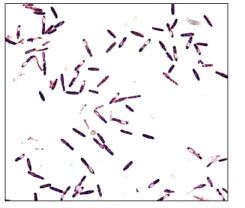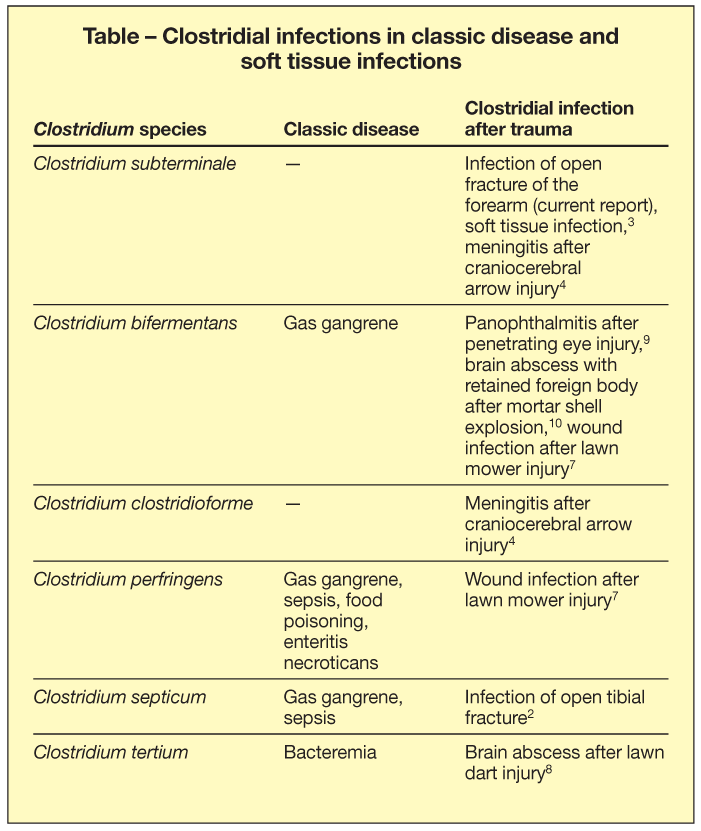Clostridium subterminale - Infection Secondary to an Open Fracture
Clostridia are anaerobic, spore-forming, gram-positive bacilli that are ubiquitious in nature. They can be isolated from soil and the GI tract of animals and humans.1
Key words:Clostridium subterminale, Soft tissue infection, Open fracture
Clostridia are anaerobic, spore-forming, gram-positive bacilli that are ubiquitious in nature. They can be isolated from soil and the GI tract of animals and humans.1 These organisms are responsible for a vast variety of human diseases, such as tetanus, botulism, sepsis, and severe soft tissue infections. Generally, infection occurs after inoculation of environmental spores into the host and subsequent germination in an anaerobic wound milieu.
Some strains of Clostridium perfringens, Clostridium histolyticum, Clostridium novyi, and Clostridium septicum are highly pathogenic; possess necrotizing toxins; and may cause life-threatening diseases, such as clostridial myonecrosis (gas gangrene) and sepsis.1 Clostridial infections are therefore recognized as serious complications of open fractures contaminated with soil.2
Case report
During an outdoor soccer game, an 18-year-old man fell to the ground and fractured his right forearm. A radiograph revealed a complete fracture of both the proximal ulna and the radius. Soft tissue injury was minimal, and a grade 1 open fracture was diagnosed. The wound was cleaned, and a local iodine-containing antiseptic was applied. An open reposition and implantation of 2 titanium-coated metal plates was performed, and 2 Robinson drains were placed near the plates. The patient received oral sultamicillin (ampicillin/sulbactam) 375 mg bid postoperatively for 2 days.
The drains were removed 3 days later. Fourteen days after the operation, a purulent discharge was observed at the site of the former access to the ulna. A sample of the discharge was sent for examination for bacteria, and antibiotic treatment with sultamicillin was restarted. Two days later, the former wound was surgically reopened and inspected. The osteosynthesis was stable, but parts of the fascia were inflamed and therefore were resected.
A swab specimen was taken and sent for bacterial culture. The wound was cleaned and a Robinson drain and a carrier system were inserted into the cavity of the wound. The drain was removed after 2 days, and the carrier was removed 1 week lat-er. At that time, the condition of the wound was unremarkable.
However, after another 11 days, the patient noticed a painful red swelling and a purulent discharge at the distal wound margin. The antibiotic treatment was switched to oral clindamycin 300 mg qid but was discontinued after 48 hours because a rash developed.

Figure –The subterminal spores within Clostridium subterminale bacteria are clearly visible as bright areas in this Gram stain of the anaerobic culture (magnification ×1000).
In all specimens, swarming gram-positive rods with subterminally located spores grew in the anaerobic culture (Figure). Amplification and sequence analysis of the bacterial 16S ribosomal RNA gene showed 100% identification of Clostridium subterminale. All aerobic cultures remained sterile. The isolate was susceptible to penicillin, ampicillin/sulbactam, imipenem, metronidazole, clindamycin, and moxifloxacin, but it was resistant to cephalosporins and aminoglycosides.
Another surgical revision was performed and a fistula containing a purulent secretion was discovered and resected. The titanium plates were removed, and the wound was cleaned using jet lavage. A gentamicin-containing sponge was embedded. Eventually, an external fixator was installed. During a 7-week follow-up, healing of the wound was uneventful and radiographic examination showed increasing stability of the fracture sites.
DiscussionC subterminale is one of the species of Clostridium that is most frequently isolated from soil. Because of its low pathogenicity, however, it is very rarely associated with human infection. Soft tissue infection was described in 19753 and meningitis secondary to a penetrating arrow injury of the brain concomitant with Clostridium clostridioforme infection was reported in 1996.4 In those cases, inoculation of environmental spores followed a traumatic injury. Additional reports describe involvement of C subterminale in a pleuropulmonary infection in a patient with cardiac failure in 19895 and in septicemia in an immunosuppressed transplant recipient in 2003.6
Environmental clostridial spores may be inoculated in intact tissue by sharp-edged devices, such as lawn mower blades,7 arrows,4 darts,8 and other implements,9,10 or by direct contamination of preexisting wounds with soil, as in open fractures.2 Abscess formation often occurs 3 to 5 weeks after the injury and is usually found around bone fragments or foreign bodies.4 In the case described here, symptoms began 2 weeks after the initial trauma. C subterminale was the only organism isolated from the wound. It was cultured from all 7 specimens obtained during multiple surgical resections.
Many Clostridium species have been implicated in infections after traumatic injuries (Table). Recently, an upsurge of toxigenic clostridial soft tissue infections, as well as wound botulis

m and tetanus,11 has been described among injection drug users in the United Kingdom. Among the many Clostridium species, only a few are toxigenic, but they are well known for causing life-threatening diseases. Most clostridia are obligate anaerobic bacilli, but some species may be aerotolerant, such as C histolyticum, one of the agents that cause gas gangrene.1
Clostridia have shown variable resistance to cephalosporins and quinolones. They are usually resistant to aminoglycosides,1,6 and a number of species are frequently resistant to clindamycin.12 Some species produce penicillinase, which confers resistance to penicillin. Chloramphenicol, acylaminopenicillins with -lactamase inhibitors, carbapenems, and metronidazole are active against most clostridia.1,12 In severe infections with C subterminale, combination therapy is preferable.6
In a patient in whom septicemia developed after an allogeneic cord blood transplant, ceftazidime and vancomycin were therapeutically successful.6 However, in a patient in whom meningitis developed after a craniocerebral arrow injury,4 persistence of C subterminale in the cerebrospinal fluid was noted despite treatment with penicillin, cefotaxime, and clindamycin. The patient eventually recovered after chloramphenicol was administered. Unfortunately, no antibiotic susceptibility pattern was reported.
In the case described here, C subterminale was susceptible to penicillin, ampicillin/sulbactam, imipenem, metronidazole, clindamycin, and moxifloxacin but resistant to cephalosporins and aminoglycosides. The patient was initially treated with sultamicillin, followed by clindamycin and again, sultamicillin. Despite appropriate antibiotic treatment, however, numerous surgical resections, including the removal of the titanium-coated metal plates, were necessary.
In conclusion, empirical antibacterial chemotherapy should include agents that act against anaerobic bacteria if wound contamination with soil is likely, as it is in open fractures. Acylaminopenicillins with β-lactamase inhibitors or carbapenems are highly effective. If cephalosporins are used, they should be combined with metronidazole or clindamycin.
Any clostridia recovered from wounds or surgical sites should be identified to the species level to estimate the pathogenic potential of the isolate. Antibiotic susceptibility testing should always be performed. If a wound does not heal despite antibiotic treatment, early surgical intervention should be sought, and any foreign bodies and osteosynthetic material should be removed or exchanged, respectively. Even bacteria that are considered to be nontoxigenic may cause long-lasting and sometimes complicated infections, leading to prolonged and repeated health care utilization.
References:
REFERENCES
1. Allen SD, Emery CL, Lyerly DM. Clostridium. In: Murray PR, Baron EJ, Jorgensen JH, eds. Manual of Clinical Microbiology. 8th ed. Washington, DC: American Society for Microbiology Press; 2003:835-856.
2. Lucas HK, Speller DC, Stephens M. Chronic Clostridium septicum infection of a tibial fracture: a case report. Injury. 1976;8:117-119.
3. Gorbach SL, Thadepalli H. Isolation of Clostridium in human infections: evaluation of 114 cases. J Infect Dis.1975;131(suppl):S81-S85.
4. Neal G, Downing EF. Clostridial meningitis as a result of craniocerebral arrow injury. J Trauma. 1996;40:476-480.
5. Gubler JG, Wuest J, Hany A. Pleuropulmonary infection due to Clostridium subterminale.J Infect. 1989;19:277-280.
6. Miyazaki K, Mori T, Takayama N, et al. Clostridium subterminale septicemia in a recipient of allogeneic cord blood transplantation. Intern Med. 2003;42:374-375.
7. Brook I. Recovery of anaerobic bacteria from wounds after lawn-mower injuries. Pediatr Emerg Care. 2005;21:109-110.
8. Lew JF, Wiedermann BL, Sneed J, et al. Aerotolerant Clostridium tertium brain abscess following a lawn dart injury. J Clin Microbiol. 1990;28:2127-2129.
9. Pencek TL, Burchiel KJ. Delayed brain abscess related to a retained foreign body with culture of Clostridium bifermentans. J Neurosurg. 1986;64:813-815.
10. Rehany U, Dorenboim Y, Lefler E, Schirer E. Clostridium bifermentans panophthalmitis after penetrating eye injury. Ophthalmology. 1994;101:839-842.
11. Brett MM, Hood J, Brazier JS, et al. Soft tissue infections caused by spore-forming bacteria in injecting drug users in the United Kingdom. Epidemiol Infect. 2005;133:575-582.
12. Gorbach SL. Clostridium perfringens and other clostridia. In: Gorbach SL, Bartlett JG, Blacklow NR, eds. Infectious Diseases. 2nd ed. Philadelphia: WB Saunders; 1998:1925-1933.